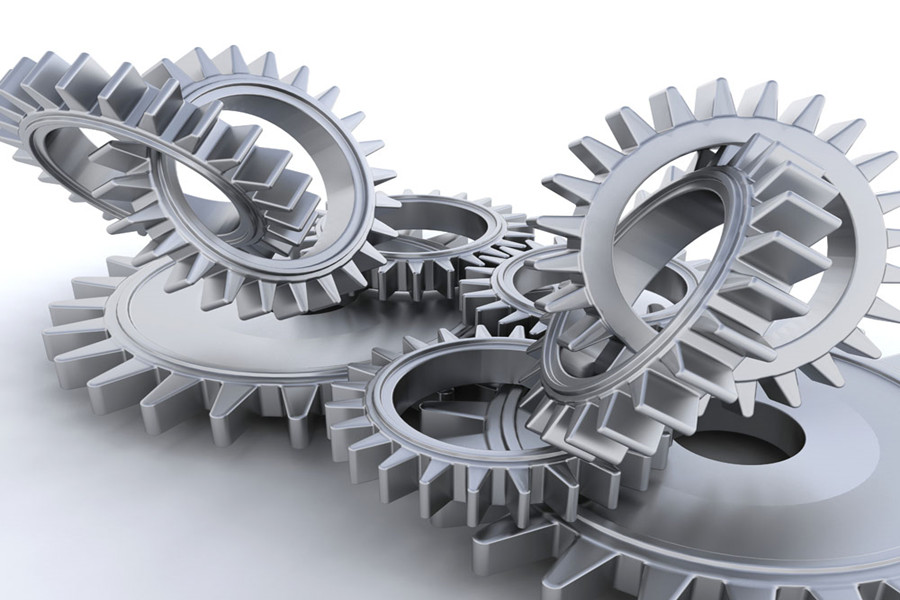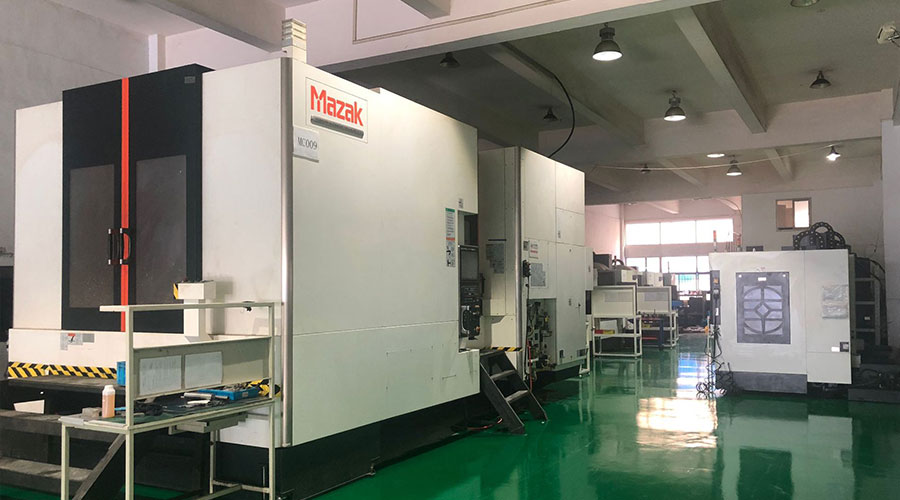Abstract: A certain analysis of various influencing factors of gear heat treatment deformation has been made. It is pointed out that the heat treatment deformation of gear parts is mainly affected by various factors such as part structure, material, forging, machining, heat treatment process and equipment.
1. Introduction to carburizing heat treatment
The shafts and gears commonly used in automobiles need to be forged, normalized, and machined, and then carburized, quenched and tempered. The superficial layer is a carburized layer with higher hardness, and the core is a carburized layer with good comprehensive mechanical properties. The structure, these structures and the residual stress generated after quenching have a decisive effect on the mechanical properties of shafts and gears. At present, carburizing heat treatment is widely used in our company, and it is also a relatively mature heat treatment process. The purpose of carburizing is to obtain a high-carbon surface layer and a low-carbon core to ensure high plasticity and toughness of the core, high surface hardness, and increase the hardness, wear resistance and fatigue strength of the workpiece.
2. Analysis of heat treatment deformation
1. Factors affecting heat treatment deformation
The heat treatment of parts must be accompanied by changes in shape and size, which are the result of the joint action of tissue stress, thermal stress and gravity. Both the structural stress and the thermal stress are heat treatment stresses. The structural stress refers to the stress generated when the structural transformation of each part caused by the different time of cooling of each part during the heat treatment process is different. The thermal stress is due to the temperature difference of each part of the workpiece, which leads to thermal expansion. Stress caused by uneven cold shrinkage. During quenching, there are two main deformations of parts: geometrical deformation, mainly due to size and shape deformation, caused by quenching stress; volumetric deformation, mainly due to proportional expansion or contraction of the volume of the workpiece, which is the ratio of phase change Caused by volume changes.
There are many factors that affect the heat treatment deformation of parts. The quenching process only releases the potential deformation stresses of the parts, and these potential deformation stresses are continuously accumulated during the entire processing of the parts. They can be summarized as the chemical composition of the material, the forging temperature and the forging process during the forging process. Post-cooling rate, feed rate, feed rate, cutting speed, clamping method during machining, heating rate, cooling rate, heating temperature and other factors during heat treatment. The heat treatment process is the final process, and all upstream processes will plant seeds for heat treatment deformation of parts. Therefore, the study of heat treatment deformation cannot solely study the heat treatment process itself, but should focus on the structure, materials and all processing processes of the parts.

2. Annealing process
The metal deviating from the equilibrium state is heated to a higher temperature, kept for a certain period of time, and then slowly cooled to obtain a structure close to the equilibrium state. Various process methods are collectively referred to as annealing. The purpose of annealing is to homogenize the chemical composition, improve the mechanical properties and process performance, eliminate or reduce internal stress, and provide a suitable internal structure for the final heat treatment of the parts.
3. Complete quenching process
The hypoeutectoid steel or its parts are heated to a temperature above the Ac3 point, and then cooled at a cooling rate greater than the critical cooling rate after holding to obtain a martensitic structure. The heat treatment to improve the strength, hardness and wear resistance is called complete quenching.
3. Examples of parts heat treatment deformation test
Our company produces a kind of gear parts. The schematic diagram and the machining position after heat treatment are shown in Figure 1. The process flow of this part is blanking→forging→normalizing→finishing turning→hobbing→inserting spline→shaving→carburizing→quenching→tempering→shot blasting→grinding→car end face and inner hole. The material is 8620RH, and the heat treatment technical requirements are: the depth of the hardened layer is 0.84-1.34mm, the surface hardness is 58-63HRC, the core hardness is 30-45HRC, and the metallographic structure meets the TES-003 standard.
The output of parts is relatively large, and the materials are prepared in tandem. Its diameter is large (219.2~219.45mm), the wall thickness is thin (27.05mm), and the structure is not completely symmetrical, that is, the end face of B has a small diameter inner hole, while A The end face side is an internal spline with a large diameter, which causes the thermal deformation of the end faces (A and B end faces) of this type of structural parts to have the characteristics of inconsistent trends.
At the end of 2016, after the sudden heat treatment of the finished part, the runout of the B end face was out of tolerance (the process requires the runout value of the hot back end face to be ≤0.06mm), which caused the drum shape and the tooth direction angle to be out of tolerance. For the remaining parts in the batch that have completed the forging and hot machining processes, temporary tests and fine-tuning processes are carried out during the heat treatment process to maximize the control of thermal deformation and reduce the failure rate of parts.
1. Original heat treatment process of parts
The heat treatment equipment originally used for the parts is the AICHELIN 42 station annular rotary bottom continuous furnace, which integrates pre-oxidation, carburizing, quenching, cleaning and tempering. Carburizing uses nitrogen and methanol as the basic atmosphere, and acetone as the enriching agent. According to the nitrogen-methanol atmosphere theory, the supply ratio is methanol: nitrogen = 1L/h: 1.1m3/h, and the CO content value meter is set to 20%. The original heat treatment process is: pre-oxidation → carburizing → oil quenching → cleaning and tempering.
2. Temporary test, fine-tuning process and result analysis of the heat treatment process
(1) Increase annealing process and result analysis
High temperature tempering furnace is used for annealing, the annealing process is set to 400℃ for 2 hours, and the furnace is cooled to 350℃ and then air-cooled, and then carburized and quenched. One-to-one corresponding measurement of the end jump values before and after heating.
(2) Adjust quenching stirring parameters and result analysis
The prerequisite for fine-tuning the heat treatment process parameters is to ensure that the parts meet the various heat treatment technical indicators required by the drawing. For the general quenching process, the most ideal state is that the part completes the martensitic transformation within the set time of the fast stirring speed, and then reduces the cooling rate within the set time of the slow stirring speed to reduce its thermal expansion The deformation caused by cold shrinkage can minimize the thermal deformation of the parts while ensuring the completion of the heat treatment technical indicators.
(3) Increase annealing process + adjust quenching stirring parameters and analysis
Based on the above two tests (the thermal deformation end jump is small after the annealing process is added (0.033), and the quenching and stirring parameters are adjusted, the thermal deformation end jump is large (0.057), and the dispersion is small (0.015)), these two methods are at the same time Used for this batch of parts, that is, the parts are annealed first, and then carburized and quenched with the adjusted stirring parameters, and the thermal deformation of the parts is observed.
First, use high temperature tempering furnace for annealing process + adjust quenching and stirring parameters: use high temperature tempering furnace for annealing process, and then adjust quenching and stirring parameters for carburizing and quenching process. The measurement results of the front and back jumps of the part heat treatment are shown in Figure 5. The thermal back end jump meets the process requirements, the average thermal deformation end jump is 0.034mm, and the standard deviation of the thermal back end jump is 0.018.
Second, use a ring furnace for the annealing process + adjust the quenching and stirring parameters: taking into account the logistics transfer problem, the heat treatment process is further optimized, and the annealing process is carried out in the pre-oxidation zone of the ring furnace. According to the annealing process requirements, it enters the main furnace after holding at 400°C for 2 hours Carburizing, while adjusting the mixing parameters.
Comparing the above four fine-tuning processes with the original process and its thermal deformation results, it can be seen that the thermal back-end jump value of the remedial process of only adjusting the quenching and stirring parameters is larger, which is greater than the process type of adding annealing + adjusting the quenching and stirring parameters, and selecting the latter remedial Process type, considering the feasibility of the production site, the process type of annealing in the pre-oxidation zone of the ring furnace + stirring parameter adjustment is better than the process type of high temperature tempering furnace annealing + stirring parameter adjustment.
Using the optimized remedial process: annealing in the pre-oxidation zone of the ring furnace + adjustment of stirring parameters, the remaining parts of the batch are produced, and the unqualified rate of the parts is reduced from 30% at the sudden time to 6%, which greatly reduces the unqualified rate , Which effectively reduces economic losses for the company.
4, the conclusion
After machining, adding an annealing process before carburizing and quenching and adjusting the quenching stirring parameters can effectively improve the heat treatment deformation of the parts, and provide a feasible remedy process for similar problems in the future. However, the heat treatment deformation of parts can not be completely solved by adjusting the heat treatment process. Each process before heating will have a certain impact on the deformation of the final heat treatment. The conformity of the final product requires the coordination and cooperation of each process to find a suitable process. In order to improve the qualified rate of parts and ensure product quality.
Link to this article: Influencing Factors and Processes of Heat Treatment Deformation of Gear Parts
Reprint Statement: If there are no special instructions, all articles on this site are original. Please indicate the source for reprinting:https://www.cncmachiningptj.com/,thanks!
 Sheet metal, beryllium, carbon steel, magnesium, 3D printing, precision CNC machining services for heavy equipment, construction, agriculture and hydraulic industries. Suitable for plastics and rare alloys machining. It can turn parts up to 15.7 inches in diameter. Processes include swiss machining,broaching, turning, milling, boring and threading. It also provides metal polishing, painting, surface grinding and shaft straightening services. The production range(include aluminum die casting and zinc die casting) is up to 50,000 pieces. Suitable for screw, coupling, bearing, pump, gearbox housing, drum dryer and rotary feed valve applications.PTJ will strategize with you to provide the most cost-effective services to help you reach your target,Welcome to Contact us ( [email protected] ) directly for your new project.
Sheet metal, beryllium, carbon steel, magnesium, 3D printing, precision CNC machining services for heavy equipment, construction, agriculture and hydraulic industries. Suitable for plastics and rare alloys machining. It can turn parts up to 15.7 inches in diameter. Processes include swiss machining,broaching, turning, milling, boring and threading. It also provides metal polishing, painting, surface grinding and shaft straightening services. The production range(include aluminum die casting and zinc die casting) is up to 50,000 pieces. Suitable for screw, coupling, bearing, pump, gearbox housing, drum dryer and rotary feed valve applications.PTJ will strategize with you to provide the most cost-effective services to help you reach your target,Welcome to Contact us ( [email protected] ) directly for your new project.
Link to this article:Influencing Factors and Processes of Heat Treatment Deformation of Gear Parts
Reprint Statement: If there are no special instructions, all articles on this site are original. Please indicate the source for reprinting.:Cut Wiki,Thanks!^^
